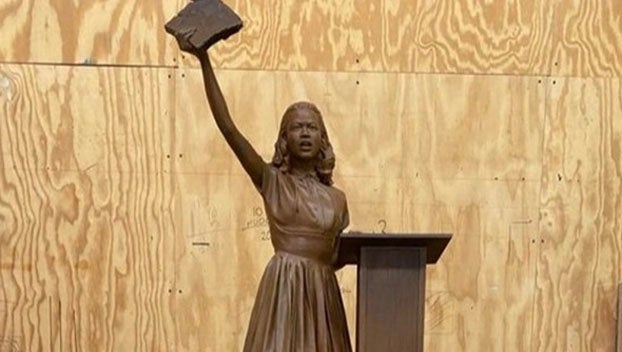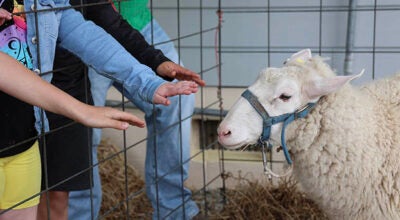Barbara Rose Johns statue gets prelim approval, moves forward
Published 2:09 am Tuesday, August 15, 2023
|
Getting your Trinity Audio player ready...
|
FARMVILLE – We’re one step closer to seeing a statue of Barbara Rose Johns in the U.S. Capitol. Staff of the Virginia Department of Historical Resources confirmed that the “preliminary model” has been approved by federal officials. Now it’s time to build the full-size version and go through the same process.
“Commissioning a statue for placement in the U.S. Capitol is a monumental undertaking,” said Julie Langan. She serves as Director of the Virginia Department of Historic Resources. “We knew from the outset that this would be a lengthy process, as it should be for something so enduring and impactful. All involved are pleased with our progress and that we are a bit ahead of schedule.”
This is a process that started almost three years ago. In December 2020, the Commission for Historical Statues in the United States Capitol voted to replace a statue of Robert E. Lee with one of the Farmville civil rights leader. But that effort stalled, due to the pandemic and related challenges. Now things are moving along.
Johns was chosen from a group of five finalists, to be represented in the U.S. Capitol. Commission members said they decided on Johns because of her connection to the Supreme Court case Brown v. Board of Education, which found that racial segregation in schools is unconstitutional.
Now to be clear, all that’s been approved so far is the preliminary model, a smaller version just so officials could see what it would look like. There’s still several steps left before it will be up on display.
Taking the next step
The next step has already started, which is to begin building the full-scale model. Once the full-scale version is finished, it will be submitted to the commission for approval, then to the Architect of the Capitol and the federal Joint Committee on the Library, which has final approval over statues in the U.S. Capitol.
Even then, it won’t be finished. Once all of those groups approve of the full-scale model, it’ll be built again, this time in bronze. And each of those groups will have to sign off on the bronze version as well before it can go up on display.
As for how long this will take? About a year. Langan estimates that a ceremony for the statue’s unveiling in the U.S. Capitol will take place late in the fall or winter or 2024.
Who was Barbara Rose Johns?
While long-time residents may remember her, this is for some of our newer readers. Barbara Rose Johns was a 16-year-old high school student who attended Robert Russa Moton High School, the first free-standing segregated high school for African-American students in Prince Edward County. Originally built in 1939, its max capacity was to hold exactly 180 students, but had over 477. As such, there was overcrowding in the classrooms, along with subpar conditions and hand-me-down education materials.
Johns was one of the first students to do something about that. On April 23, 1951, after months of deliberation and meditation, she decided to lead a strike.
That protest eventually led to a court case being filed. That case was led by Oliver Hill and Spottswood Robinson, who were attorneys in the Richmond branch of the National Association for the Advancement of Colored People (NAACP). However, the attorneys took some convincing to take the job.
When the students were on strike, Rev. Francis Griffin got Barbara Johns and one of her classmates, Carrie Stokes, in contact with those attorneys. They wrote a letter, pleading with them to take their case.The attorneys were not interested in Prince Edward County. They were actually trying to take a case out in Pulaski, west of here. But they needed to drive through Farmville to get to Pulaski anyway, so they were convinced to stop and hear the students out.
One thousand people packed Farmville’s First Baptist Church for that meeting, which happened on May 3, 1951. Through the persuasion of Johns and Rev. Griffin, as well as the other community members who came out that day, the attorneys agreed to take the case.
The case eventually went to federal court and merged with a number of others out of South Carolina, Delaware, Washington D.C. and Topeka, Kansas. Those five cases combined to form Brown v. Board of Education, using the name of Oliver Brown, who was a plaintiff in the Kansas case.
More about her history
Barbara Rose Johns watched all of that play out from a different state, however. The protest she started and the court case that followed drew racist threats. Fearing for her safety, the Johns’ family decided she needed to move.
Johns moved to live with her Uncle Vernon Johns in Montgomery, Alabama. So she very much didn’t get to see directly the fruits of her labor. The rest of the students and the rest of the community did continue to move it forward after that.”
After moving to Alabama, Johns earned a degree in library science from Drexel University. She later married William Powell, moving with him to Philadelphia and raising five children. She also became a librarian for the Philadelphia school system, a position she held until her death in 1991 from bone cancer.
This planned statue is the most recent addition to her legacy. In 2017, the Virginia attorney general’s offices were renamed in her honor. Her story was recently added to the Standards of Learning for 4th grade Virginia studies and 11th grade U.S. History. And in 2018, the General Assembly made April 23 Barbara Johns Day throughout the Commonwealth.





